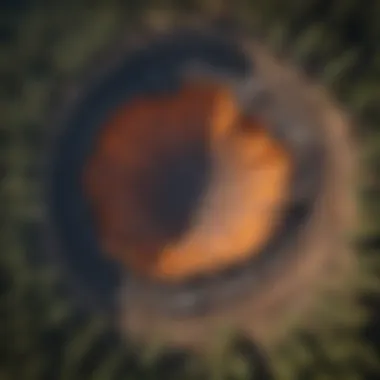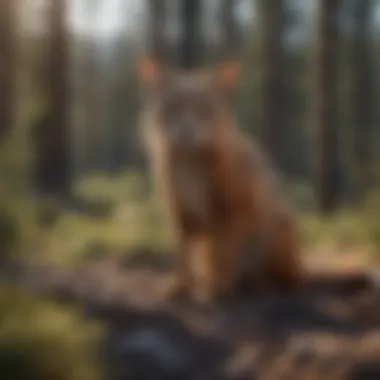Exploring Flagstaff Crater: Geological and Ecological Insights


Intro
The significance of Flagstaff Crater extends beyond its physical presence in the landscape. This article will present an extensive exploration of the crater, detailing its geological aspects, ecological contributions, and its critical role in forestry practices. Understanding the intersection of landforms and woodland ecosystems is key to valuing the crater's contributions to our environment and conservation strategies.
This overview aims to highlight several key elements of Flagstaff Crater, capturing its rich biodiversity, features of its ecosystem, and the sustainable practices that are essential for its preservation. The insights gained here will be valuable not only for nature enthusiasts but also for professionals engaged in forestry and conservation efforts.
Understanding Flagstaff Crater
Understanding Flagstaff Crater requires looking at the unique geological, ecological, and cultural elements that define it. This knowledge is essential for a comprehensive appreciation of the crater and its relevance in various fields. The interplay between its geological formation and ecological significance highlights why this site is crucial for both research and conservation efforts. Recognizing the factors that contribute to its formation and biodiversity helps professionals in forestry and environmental science develop more effective conservation strategies.
Geological Formation
Volcanic Activity and Structure
The volcanic activity that created Flagstaff Crater is a fundamental aspect of its geological formation. The crater originates from a series of eruptions, leading to the distinct structure we see today. One key characteristic is the presence of the basalt lava flow that forms the crater walls. This structural stability is beneficial as it allows for a diverse range of flora and fauna to thrive. The unique feature of this volcanic structure is its relatively well-preserved state, which provides insights into the region's volcanic history. However, the walls can be prone to erosion, which is a significant disadvantage when considering long-term preservation efforts in the area.
Age and Erosional History
The age and erosional history of Flagstaff Crater are equally significant when understanding its overall geological context. Dating methods indicate that the crater formed approximately 700,000 years ago, making it relatively young in geological terms. This youthful aspect plays a crucial role in its current landscape and ecological habitats. The unique feature of the erosion process at Flagstaff Crater is that it has occurred at different rates in various locations, leading to a complex topography. However, this variability also presents challenges for scientists aiming to monitor and manage the area, as erosion may impact species diversity and habitat stability.
Location and Size
Geographical Context
The geographical context of Flagstaff Crater places it within a unique ecological niche. Located in Northern Arizona, it is surrounded by the Coconino National Forest. Its location is essential for understanding various ecological interactions within the ecosystem. The proximity to diverse landscapes allows for a high degree of biodiversity, making it a popular spot for research and exploration. However, its accessibility can lead to human disturbances that may affect its fragile ecosystems.
Dimensions and Scale
Flagstaff Crater covers an area of approximately 1.2 miles in diameter, presenting a considerable scale for study. This dimension allows for a variety of microenvironments within the crater itself. One significant aspect of its size is that it hosts a range of habitats, promoting diverse wildlife and plant species. While these dimensions offer benefits for biodiversity, they also pose challenges for effective management and conservation, as larger areas are harder to monitor and protect.
"Understanding the multilayered aspects of Flagstaff Crater is essential for formulating effective conservation strategies."
In summary, each topic addressed in the section about Flagstaff Crater provides critical insights. The geological characteristics create a foundation for understanding its ecological diversity, while its geographical context emphasizes the need for conscientious management. Recognizing these elements is vital for further research and conservation planning.
Ecological Significance
The ecological significance of Flagstaff Crater is profound. This section explores its unique vegetation and wildlife habitat, both of which contribute to the overall health of the ecosystem. Understanding these elements is crucial for conservation efforts and sustainable land management.
Unique Vegetation
Flora Diversity
The flora diversity around Flagstaff Crater plays an essential role in supporting the entire ecological system. The crater's unique geological features foster a variety of plant life. This diversity includes several species that are particularly well-adapted to the local conditions. An important aspect of flora diversity is its ability to stabilize the soil and reduce erosion, which is a crucial factor in maintaining the area’s landscape. This feature benefits not only the plants themselves but also the entire ecosystem by providing the necessary conditions for different wildlife species.
Endemic Species
Endemic species in Flagstaff Crater add another layer of ecological importance. These species are found nowhere else and often represent key indicators of environmental health. Their presence supports biodiversity, which is vital for ecosystem resilience. The unique feature of endemic species is that they are highly specialized to their specific habitat. This specialization can be a double-edged sword, as it makes them particularly vulnerable to changes in the environment, such as climate change or human interference. Protecting these endemic species is necessary for preserving the integrity of the ecosystem.
Wildlife Habitat


Animal Species Inhabitance
The animal species that inhabit Flagstaff Crater are diverse and integral to the ecological system. Each species contributes to the ecological balance, serving specific roles such as pollinators, predators, or scavengers. This interdependence highlights the importance of animal species inhabitance in maintaining healthy ecosystems. The diverse repetoire of animals found in the crater also offers opportunities for scientific research, which enhances our understanding of ecological interactions.
Ecosystem Interdependence
Ecosystem interdependence is a key component in understanding Flagstaff Crater's ecology. Every plant and animal species within the crater relies on others for survival. This intricate web of relationships showcases the importance of biodiversity. The disruption of any one species can have ripple effects throughout the ecosystem, leading to unforeseen consequences. Emphasizing the significance of these interdependencies reinforces the need for conservation efforts aimed at preserving both the flora and fauna that call Flagstaff Crater home.
"Protecting the delicate balance within ecosystems like Flagstaff Crater is not only a matter of conservation but a necessity for the survival of intricate life forms that thrive there.”
In summary, exploring the ecological significance of Flagstaff Crater provides valuable insights into its flora and fauna, as well as their interrelationships. Understanding these dynamics is crucial for professionals committed to effective forestry and environmental stewardship.
Cultural and Historical Context
The cultural and historical context surrounding Flagstaff Crater is of paramount importance, as it highlights the significance of this geographical feature beyond its geological and ecological aspects. The crater has long been a site of interest not just for scientists but also for indigenous peoples and modern artists. Understanding the historical usage and cultural narratives offers deeper insights into the relationship between people and landforms.
Indigenous Significance
Historical Usage
The historical usage of Flagstaff Crater dates back to ancient indigenous groups. The area was used for various purposes, including spiritual ceremonies and as a gathering place for trading. This usage contributes to a broader understanding of how landscapes are integrated into cultural practices.
One key characteristic of this historical usage is its emphasis on connection with the land. Indigenous peoples viewed the crater not just as a physical space but as part of their identity. This perspective is a beneficial choice for this article because it highlights the profound respect for natural elements inherent in indigenous cultures.
A unique feature of this historical usage is the perpetuation of traditional ecological knowledge. This knowledge includes sustainable practices that have been passed down through generations, which are advantageous in the context of modern conservation efforts. It shows that historical practices can inform current land management strategies, although it is essential to recognize the challenges that arise when integrating modern scientific approaches with traditional knowledge.
Cultural Narratives
Cultural narratives surrounding Flagstaff Crater provide a narrative richness that enhances our understanding of this landscape. These narratives often reflect the values, beliefs, and historical experiences of the indigenous communities connected to this area.
One important characteristic of these cultural narratives is their storytelling aspect. They serve as a means to pass down wisdom and connect generations. This storytelling is a prevalent feature, making it a compelling topic for this article, as it emphasizes the intersection of culture and environment.
The unique feature of these narratives is the way they encapsulate the essence of place. Cultural narratives often carry lessons about nature’s cycles, spirituality, and kinship with the environment. While these stories can foster awareness and appreciation for the land, it is crucial to consider the potential for misconceptions if the narratives are oversimplified.
Modern Interpretations
Artistic Representations
Artistic representations of Flagstaff Crater illustrate the impact of its natural beauty on creativity. Artists have depicted the crater in various forms, from paintings to poetry, reflecting its grandeur and mystery. This contribution is vital in creating a visual and emotional connection to the site, encouraging public engagement.
The key characteristic of these artistic expressions is their ability to capture personal interpretations of the landscape. This diversity is a valuable addition to this article, as it reveals how different perspectives can provide a richer understanding of the site.
One unique aspect of these representations is how they can initiate dialogue about conservation and heritage. While art has the potential to inspire and mobilize action, it can also lead to romanticization of nature that may overlook important issues related to land use and management.
Scientific Research Contributions
Scientific research contributions related to Flagstaff Crater have been multifaceted, enriching both ecological understanding and cultural awareness. Research initiatives focus on geology, ecology, and anthropology, among other fields. This interdisciplinary approach contributes to a holistic view of the crater’s significance.
A key characteristic of scientific research is the rigorous methodology that enables a thorough investigation of the crater’s features. This attribute makes scientific research a beneficial aspect to include in this article as it grounds the narrative in evidence-based findings.


One unique feature of scientific research is its capacity to influence policy and conservation strategies. However, it is important to balance scientific insights with indigenous perspectives, thus enriching the overall approach to land management. By synthesizing these areas, the article can present a comprehensive narrative that appreciates both past and present interactions with this unique landscape.
Flagstaff Crater and Forestry Practices
Flagstaff Crater serves as an important site for various forestry practices due to its unique geological features and ecological significance. The management of land in this area focuses on sustainable practices that preserve the natural environment while also supporting the surrounding ecosystems. Understanding the interplay between the crater's geological characteristics and forestry initiatives can lead to better conservation efforts and enhanced biodiversity.
Sustainable Land Management
Conservation Methods
Conservation methods implemented around Flagstaff Crater encompass a range of practices designed to protect natural resources. These methods often involve preserving existing habitats and reducing human impact. One key characteristic of these methods is community involvement, which aids in maintaining a balance between human activity and natural conservation. This approach fosters a sense of ownership among locals.
The unique feature of these conservation methods is the emphasis on adaptability. As environmental conditions change, management strategies can be modified to respond effectively. However, a potential disadvantage might be the challenge of securing ongoing community engagement and funding, which can affect the success of these practices. Understanding these dynamics is crucial for effective management.
Restoration Projects
Restoration projects around Flagstaff Crater aim to rehabilitate areas that have experienced ecological decline. These projects may include replanting native species, controlling invasive plants, and restoring water quality. The hallmark of successful restoration is the establishment of self-sustaining ecosystems, which contribute to overall biodiversity.
A notable aspect of restoration projects is their long-term vision. Restoration efforts are often slow to yield visible results, requiring patience from stakeholders. However, one major advantage is the diversity of techniques that can be utilized, allowing for tailored solutions that suit specific environmental conditions. Conversely, the complexity of these projects can pose challenges in monitoring progress and effectiveness.
Research and Studies
Case Studies
Case studies related to Flagstaff Crater provide valuable insights into effective forestry practices and ecological management. These investigations often spotlight local success stories where management strategies led to significant improvements in ecosystem health. They highlight the importance of data-driven decision-making in conservation efforts.
The key characteristic of these case studies is their ability to illustrate real-world applications of theoretical concepts. This aspect adds credibility and relevance to the discussions about forestry practices. However, one limitation is that individual case studies may not always be generalizable across different contexts, necessitating caution when applying findings to broader situations.
Ecological Impact Assessments
Ecological impact assessments (EIAs) play a critical role in understanding the effects of various activities on the Flagstaff Crater environment. These assessments help in identifying potential negative impacts on flora and fauna before initiating new projects. A significant characteristic of EIAs is their systematic approach, which involves detailed studies over multiple ecological indicators.
A unique feature of these assessments is their preventive nature, allowing for informed decision-making that prioritizes ecological integrity. They help in shaping policies that are environmentally responsible. Nonetheless, a challenge with EIAs lies in ensuring that assessments are comprehensive and take into account the nuances of complex ecosystems, while avoiding oversimplification that could lead to uninformed decisions.
Visiting Flagstaff Crater
The aspect of visiting Flagstaff Crater is important for several reasons. Firstly, it sees great footfall due to its unique geologic features and rich biodiversity. This location not only captivates nature enthusiasts but also provides significant opportunities for education and environmental awareness. By engaging with the crater, visitors can have first-hand experience of its ecological patterns and geological significance. Moreover, understanding how to access the site ensures that visitors respect the environment while enjoying the beauty that Flagstaff Crater offers.
Access and Trails
Designated Hiking Routes
Designated hiking routes play an essential role in managing visitor access while protecting the natural environment. These trails are carefully planned to minimize impact on the surrounding ecosystem. One key characteristic of these routes is that they lead through some of the most scenic vistas of the crater, allowing hikers to enjoy stunning views. They are a popular choice because they cater to various fitness levels.
A unique feature of the hiking routes is their distinct markers, ensuring that hikers stay on the path. This helps prevent damage to native vegetation and wildlife habitats. However, while the trails are well-maintained, tourists should prepare adequately for changes in weather and terrain, which can sometimes pose challenges.
Visitor Guidelines
Visitor guidelines are crucial for ensuring a safe and enjoyable experience at Flagstaff Crater. These guidelines highlight how to engage respectfully with the environment while visiting. One of their key characteristics is the emphasis on Leave No Trace principles. This sets expectations for how individuals should conduct themselves to preserve the natural surroundings.


The guidelines include detailed information about potential hazards, like wildlife interactions and terrain difficulties. A unique aspect of the visitor guidelines is their focus on education, where each guideline also promotes ecological stewardship. However, some visitors may find these regulations restrictive, yet they are vital for sustaining the integrity of this ecosystem.
Educational Opportunities
Workshops and Programs
Workshops and programs serve as valuable resources for those looking to deepen their understanding of Flagstaff Crater. These educational opportunities are aimed at both novice learners and seasoned professionals. One key aspect is the hands-on experience, allowing participants to engage with experts in the field. This makes for a beneficial choice for those interested in ecological conservation or geological studies.
A unique feature of these workshops is the integration of field studies, where participants can observe real-life examples of the subjects discussed. However, availability can vary, and some programs may require pre-registration, which could limit access for ad-hoc visitors.
Interpretive Tours
Interpretive tours provide structured exploration of Flagstaff Crater, guided by knowledgeable individuals. These tours are important because they offer insights into the area's ecology, geology, and history. A key characteristic of these tours is the ability to address audience questions, enhancing the learning experience. This makes them a popular option for groups and educational institutions.
The unique feature of interpretive tours is their adaptability; guides often tailor content to suit the audience's interests or knowledge levels. However, the downside is that larger groups may lead to a less personalized experience. At times, tours may become crowded, which could detract from the immersive experience visitors seek.
Future Conservation Efforts
Understanding future conservation efforts at Flagstaff Crater is essential for maintaining its ecological integrity and promoting sustainable practices. As environmental threats grow, focused strategies can help preserve the unique attributes of this significant landform. These efforts often revolve around addressing current challenges and recommending proactive measures to safeguard the future of the crater's ecosystems.
Challenges Faced
Climate Change Impacts
Climate change has far-reaching effects on ecosystems worldwide, including those around Flagstaff Crater. Rising temperatures influence the flora and fauna in the region, impacting species composition and their interactions. For example, some plants may struggle to adapt to changing temperatures, which can shift their geographical ranges. This change disrupts the delicate balance that sustains biodiversity in the area.
The key characteristic of climate change impacts is that it acts as a catalyst for broader environmental transformations. This topic is beneficial for this article, as it frames the urgency needed for conservation. It opens discussions on how fluctuating weather patterns may lead to increased wildfire risks, altering the landscape and habitat availability.
A unique feature of climate change impacts is the potential for species extinction. Species unable to adapt or migrate face significant survival challenges. Thus, recognizing these challenges early can be advantageous in formulating targeted conservation strategies.
Human Encroachment
Human encroachment poses a direct threat to the ecological balance of Flagstaff Crater. Urban development continues to expand, often infringing upon natural habitats. Infrastructure construction, such as roads and buildings, damages the soil and disrupts local wildlife movement patterns. This can further lead to habitat fragmentation, which is detrimental to species that depend on expansive areas.
The primary characteristic of human encroachment is its irreversible nature. Once habitats are destroyed, they are difficult to restore. This aspect resonates strongly in the context of conservation as it highlights preventative measures. Such discussions are crucial for this article, as they prompt reflection on how land management policies can mitigate human impact on the ecosystem.
A unique feature of human encroachment is its unforeseen ramifications. Increased human activity often leads to pollution and resource depletion, affecting both wildlife and human populations. Addressing these challenges requires forward-thinking strategies in conservation efforts.
Actionable Recommendations
Community Involvement Strategies
Community involvement strategies are pivotal for fostering a sense of responsibility towards the environment among local residents. These strategies can enhance public awareness about the ecological importance of Flagstaff Crater and motivate individuals to engage in conservation activities. Educational programs that inform citizens about native species, ecosystems, and the impact of human actions can lead to healthier environments.
A key characteristic of community involvement is accessibility; when community members participate in conservation efforts, they foster a connection with nature that is beneficial for both personal well-being and ecological preservation. This engagement is an excellent choice for this article as it encourages grassroots movements that can effect change locally.
Unique features of community involvement include collaborative projects such as clean-up days or tree planting events. These initiatives not only benefit the land but also build camaraderie among residents. The resulting community spirit can lead to long-lasting positive change and environmental stewardship.
Policy Development
Effective policy development is essential for guiding sustainable land management practices around Flagstaff Crater. Policymakers must prioritize ecological considerations in planning and decision-making processes. This ensures that development initiatives do not compromise existing ecosystems. Strong policies can facilitate the implementation of conservation measures, provide resources for research, and support local initiatives that promote environmental sustainability.
The key characteristic of policy development is its potential for systemic change. Well-crafted policies can create frameworks within which conservation efforts flourish, making them particularly relevant for this article. The implication here is that proactive legislation can mitigate challenges posed by climate change and human encroachment.
Unique features of effective policies include clear guidelines for land use, protection of endangered species, and incentives for sustainable practices. Advocating for policy changes can empower communities and establish a more resilient ecological landscape.
In summary, the future conservation efforts at Flagstaff Crater must address the pressing challenges posed by climate change and human encroachment. Engaging the community in the conservation process and developing informed policies are fundamental steps in ensuring the longevity and health of this significant ecosystem.







